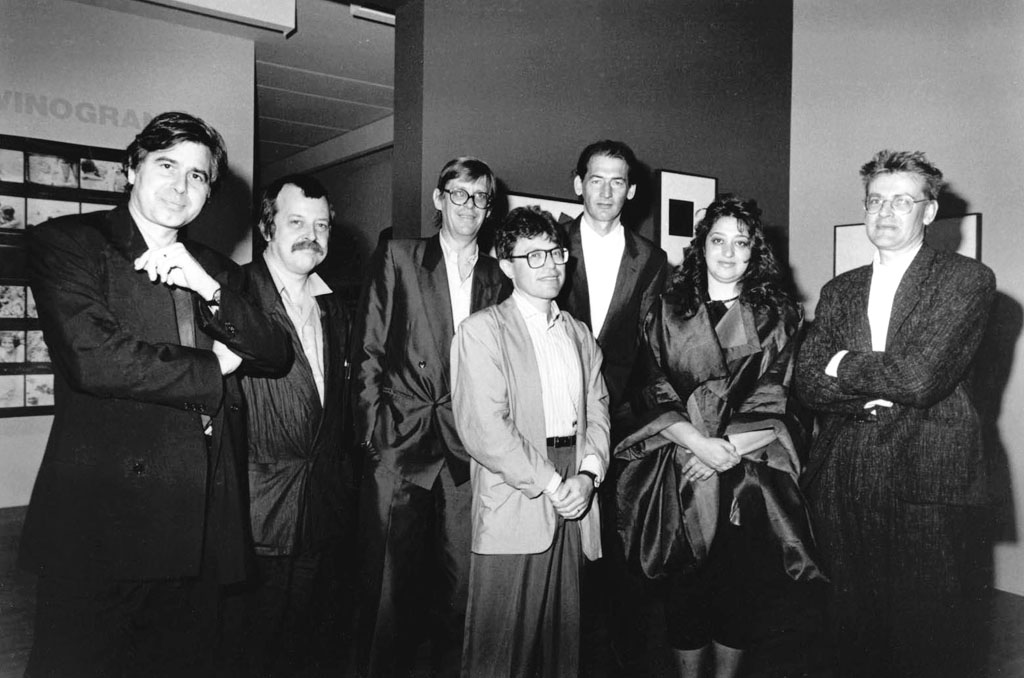22-04-22 // TO BE FINISHED IS TO BE DEAD – INTERVIEW WITH MARK WIGLEY

The architects in the Deconstructivist Architecture exhibition at MoMA, New York, 1988. From left to right: Bernard Tschumi,
Helmut Swiczinsky, Wolf D. Prix, Daniel Libeskind, Rem Koolhaas, Zaha Hadid, and curator Mark Wigley.
Bernd Upmeyer interviewed Mark Wigley, who is Professor of Architecture and Dean Emeritus at Columbia University. He is a historian, theorist, and critic who explores the intersection of architecture, art, philosophy, culture, and technology. His books include Cutting Matta-Clark: The Anarchitecture Investigation; Are We Human? Notes on an Archaeology of Design; Constant’s New Babylon: The Hyper-Architecture of Desire; and Derrida’s Haunt: The Architecture of Deconstruction. He has curated exhibitions at the Museum of Modern Art, the Drawing Center, Columbia University, Witte de With Center for Contemporary Art, Het Nieuwe Instituut, and the Canadian Centre for Architecture. The interview took place via Zoom on April 22, 2022.
[…]
BU: During the early years of your career, we believe it was in the 1980s and just after you moved from New Zealand to New York City, you founded together with Brett Steele something that you called the “Institute of Failure”, an institution seemingly for the instruction and theory of failure as opposed to success. In a lecture in 2011 at the AA School of Architecture called “Architecture of Failure” you were talking about this institute stating that success and failure are inseparable in architecture and that failure might be an architectural concept. To what extent would you describe “unfinishedness” of buildings and cities as failure, as you understand it, and what would that mean for “Unfinished Urbanism”?
Mark Wigley: I have to say that the “Institute of Failure” was a fiction. Now you can choose whether to believe what I am about to say or not but Brett Steele and I were both directing schools of architecture, myself in New York and Brett in London, that were famous for their obsession with experimentation. By definition, we were running schools that embraced failure. Then we considered the possibility that probably there should be institutes of failure. So, at a certain moment, when we started doing certain public conversations each year to compare notes, we reminisced about this institute of failure that we had supposedly constructed in New York in the 1980s that had itself failed and we told the story of this failure in order to embrace and explain what failure is. Getting back to your question, failure does relate to the question of the unfinished because to be unfinished you have to have a sense of what it could have been if it was finished. Implied in the “unfinished” is the idea of a plan. Inasmuch as designers, architects, industrial designers, and planners make plans they already construct the possibility of the unfinished. So, if what I said to you before is true, that architecture is the image of something finished, this also means that designers always live with the idea of the unfinished and feel themselves to be in the middle of something unfinished. In education and research, we will always be interested in the kind of life of the unfinished. The paradox is that the architects required to produce these objects that are supposedly finished are themselves perpetually feeling incomplete and unfinished. And that feels like failure, which is a kind of engine driving their work.

Mark Wigley and Brett Steele speaking about the institute of failure in a public conversation
moderated by Enrique Walker at Columbia University GSAPP in New York, 2012
BU: I think for architects it is also always important to call something finished to be able to move on with projects. Otherwise, they might be busy with their clients forever, who would never stop requiring more things within the same contract, which can then easily become a financial problem. Thus, the definition of a project as “finished” might many times be a very pragmatic way of dealing with projects.
MW: But I think it is not so bad to be unfinished, because to be finished is to be dead. This object that represents us is finished because it is dead, it has no future. Its future state is always the same it is now, which means it has no future. The idea to make an object that is finished is the idea to make something without a future, a future for itself, but also for those who encounter it. If we imagine that architects always fail in their attempt to finish things, you can at least say that they and their projects are alive…
… the complete interview was published in MONU #35 on the topic of Unfinished Urbanism on October 17, 2022.
Title: To Be Finished Is to Be Dead
Project: Interview with Mark Wigley
Date: April 2022
Type: Commissioned interview
Topic: Unfinished Urbanism
Organizer: MONU
Status: Published
Publications: MONU #35, P. 4-11
Interviewer: Bernd Upmeyer